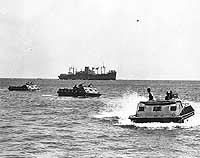
The long fight for Guadalcanal formally opened shortly after 6AM on 7 August 1942, when the heavy cruiser Quincy began bombarding Japanese positions near Lunga Point. In the darkness a few hours earlier, what was for mid-1942 an impressive invasion force had steamed past Savo Island to enter the sound between the two objective areas: Guadalcanal to the south and, less than twenty miles away, Tulagi to the north. These thirteen big transports (AP), six large cargo ships (AK) and four small high-speed transports (APD) carried some 19,000 U.S. Marines. They were directly protected by eight cruisers (three of them Australian), fifteen destroyers and five high-speed minesweepers (DMS). Led by Rear Admiral Richmond Kelly Turner, this armada was supported from out at sea by three aircraft carriers, accompanied by a battleship, six cruisers, sixteen destroyers and five oilers under the command of Vice Admiral Frank Jack Fletcher, who was also entrusted with the overall responsibility for the operation.
The great majority of these ships (9 AP, 6 AK and most of the escort and bombardment ships), with Marine Major General Alexander A. Vandegrift and the bulk of his Leathernecks, was to assault Guadalcanal a few miles east of Lunga Point. Tactically, this part of the landing went very well. There were few enemy combat troops present, and these were some distance away. The first of the Marines came ashore soon after 9AM at "Red" Beach, a stretch of grey sand near the Tenaru River. By the afternoon of the following day they had pushed westwards to seize the operation's primary object, the nearly completed Japanese airfield near Lunga Point. The surviving Japanese, mainly consisting of labor troops, quickly retreated up the coast and inland, leaving the Marines with a bounty of captured materiel, much of which would soon prove very useful to its new owners.
While the Marines consolidated their beachhead and began to establish a defensive perimeter around the airstrip, the landing of their supplies and equipment proceeded less well. Typically for these early amphibious operations, arrangements were inadequate to handle the glut of things brought ashore by landing craft. Mounds of supplies soon clogged the beaches, slowing the unloading of the ships offshore. A series of Japanese air attacks, which forced the ships to get underway to evade them, didn't help, and when the catastrophic outcome to the Battle of Savo Island and the withdrawal of Vice Admiral Fletcher's carriers forced the the big transports and cargo ships to leave on 9 August, none of them had been completely unloaded. Though the Marines had taken their objective, supply shortages would plague them in the coming weeks, as the Japanese hit back by air, sea and land in an increasingly furious effort to recover Guadalcanal's strategically important airfield.
This page features all our views of the invasion of Guadalcanal, and provides links to images of the invasion of Tulagi, Tanamboga and Gavutu islands, and of preparations for the operation.
For more pictures related to the Guadalcanal-Tulagi Invasion, see:
For other pictures related to the Guadalcanal Campaign, see:
| If you want higher resolution reproductions than the Online Library's digital images, see: "How to Obtain Photographic Reproductions." |
Click on the small photograph to prompt a larger view of the same image.
|
Photo #: 80-G-374870 Guadalcanal-Tulagi Operation, 7-9 August 1942 Amphibious shipping and landing craft off the Guadalcanal invasion beaches on the first day of landings there, 7 August 1942. Photographed from on board one of the transports. Official U.S. Navy Photograph, now in the collections of the National Archives. Online Image: 122KB; 740 x 615 pixels Reproductions of this image may also be available through the National Archives photographic reproduction system. |
 |
|
Photo #: 80-G-10973 Guadalcanal-Tulagi Landings, 7-9 August 1942 A U.S. Marine Corps M2A4 "Stuart" light tank is hoisted from USS Alchiba (AK-23) into a LCM(2) landing craft, off the Guadalcanal invasion beaches on the first day of landings there, 7 August 1942. Official U.S. Navy Photograph, now in the collections of the National Archives. Online Image: 130KB; 530 x 765 pixels Reproductions of this image may also be available through the National Archives photographic reproduction system. |
 |
|
Photo #: NH 97749 Guadalcanal Campaign, August 1942 - February 1943 U.S. Marine Corps LVT(1) amphibian tractors move toward the beach on Guadalcanal Island. This view was probably taken during the 7-9 August 1942 initial landings on Guadalcanal. Ship in the background is USS President Hayes (AP-39) U.S. Naval Historical Center Photograph. Online Image: 107KB; 740 x 610 pixels |
 |
|
Photo #: NH 97760 Guadalcanal-Tulagi Operation, August 1942 Landing craft off Beach "Red" on Guadalcanal Island, circa 7-9 August 1942, when U.S. Marines came ashore to capture the Lunga Point area and its airfield from the Japanese. The airfield is out of view to the right. The original photograph came from the illustrations package for Rear Admiral Samuel Eliot Morison's "History of United States Naval Operations in World War II", volume IV (originally published opposite page 254). U.S. Naval Historical Center Photograph. Online Image: 78KB; 740 x 625 pixels |
 |
|
Photo #: NH 97750 Guadalcanal-Tulagi Operation, 7-8 August 1942 Raising the Colors on Guadalcanal after the initial landings, circa 7 August 1942. Officer standing second from right in this group appears to be the First Marine Division commander, Major General Alexander A. Vandegrift, USMC. U.S. Naval Historical Center Photograph. Online Image: 93KB; 570 x 765 pixels |
 |
For more pictures related to the Guadalcanal-Tulagi Invasion, see:
For other pictures related to the Guadalcanal Campaign, see:
| If you want higher resolution reproductions than the Online Library's digital images, see: "How to Obtain Photographic Reproductions." |
Page made 26 January 2002
Text corrected 28 January 2004